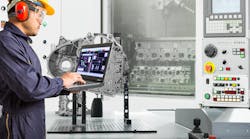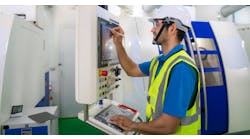Over the past decade, cloud-based software and services have become ubiquitous. Consumers have been first and fastest to embrace these offerings and delivery models, but adoption in the industrial sector has been slower and more measured. More recently, particularly as expertise and staffing have become thinner, the ability to centralize data and information for organization-wide visibility and analysis while reducing cost and complexity of on-premises infrastructure has led to a cloud migration by manufacturers. Many industrial organizations are comfortable running cloud-based applications today.
Now, the need to collect data from complex equipment on the shop floor is increasing. The growing abundance of smart machine and connected factory data is giving organizations greater opportunity to operate as efficiently and safely as possible – which is the full promise of data availability and Industry 4.0. As machines are becoming more complex, more intelligent and more networked, there is a twofold challenge.
First, organizations must be able to deploy software easily, to manage increasingly software-driven equipment. Second, they need to run, monitor, and control applications that connect machine and factory data to the cloud for performance analysis and advanced applications, such as predictive maintenance. Such applications are dependent on access to reliable shop floor data but face bandwidth and latency constraints.
Edge Computing provides the means to simplify software deployment on machines, process data, and connect what actually happens on the shop floor to the cloud. It is a key technology for operational and engineering teams to know.
What is Edge Computing?
Remote servers and clusters offering vast data storage and processing in the cloud are a world away from the factory floor. They are not designed for the harsh conditions that prevail there. More critically, remote servers and clusters are not suitable for real-time data collection at operational locations, especially where bandwidth is limited. Therefore, organizations need to bring computing power out to the manufacturing line or embedded on-machine to harness critical real-time data.
Edge Computing refers to computing power deployed at “edge” locations – factory floors, machine shops, remote equipment, and manufacturing sites – the edge of corporate or industrial networks where data is generated. It has broad applications across a range of industries, from machining to finished products, to industrial assets such as power plants, oil pipelines, and water and wastewater facilities.
Edge Computing provides the bridge between what happens at the individual machine level, factory-wide supervisory control, and the cloud. Therefore, it is an essential technology that makes Industry 4.0 a reality and accelerates digitalization at the ground level.
Smart machines and the connected factory
Individual machines are increasingly becoming smart and connected with expanded sensors and logic. Combined, they form the broader factory network with edge-to-enterprise connectivity and data management. The capability to embed Edge Computing platforms into smart machines is a natural extension that brings compute capability on-machine, adding value to equipment with software and extending the equipment lifecycle.
Reliable Edge Computing eliminates concerns about data loss, networking, and information or access not being available when required. Installed with local historians and local data storage, it can address processing requirements where bandwidth and latency are issues for edge-to-enterprise connectivity.
Specifically, purpose-built Edge Computing platforms bring four key benefits to machines on the shop floor - reliability, flexible software deployment, cybersecurity and OT/IT convergence.
Reliability and uptime
Modern Edge Computing platforms are built with operational technology (OT) in mind where machines and equipment are expected to have long lives and operate continuously without downtime or, inversely, provide maximum availability. The ideal platform is available in industrial forms that can withstand heat, vibration, and other environmental facts with Class I Div 2 UL certification going far beyond simple industrial PCs (IPCs).
Edge Computing platforms offer built-in redundancy to ensure machine software or supervisory control and historian runs without any unplanned downtime. They can be serviced while in operation. The net result is computing capability close to critical equipment that ensures reliable machine performance and non-stop data capture. This combination of uptime and efficiency offers the opportunity to improve yield, OEE, or other performance metrics.
Flexible software deployment with virtualization
An Edge Computing platform brings traditional IT capabilities to enable smart machines. The ability to deploy software on a local compute platform eliminates the need for operators to become software programmers and allows teams to standardize software deployment and management on machines. This provides a fast means to pursue new functionality and capabilities through software deployment.
Edge Computing platforms also bring an important capability from the IT world to the shop floor: application virtualization. With virtualization built into Edge Computing, teams are able to run multiple software applications concurrently in a single compute platform, rather than managing multiple IPCs for individual software applications. The ability to deploy layered software close to equipment – or start with a single application with room to grow – provides significant flexibility to increase digitalization and connectivity over time.
Ideal compute platforms also are agnostic, supporting industrial software from AVEVA, PTC, Rockwell Automation, Schneider Electric, Siemens, and others, in configurations that are pre-validated and tested. Thin-client management tools can be used so that a new set of mobile devices and other internet connected solutions can be used to extend operations and maintenance outside of the traditional control room and plant floor.
Cybersecurity
Cybersecurity remains a critical consideration in the industrial environment where malware may shutdown equipment. To address potential risks, manufacturing equipment must be secured as well as discoverable on industrial networks for regular patching and updating. An Edge Computing platform facilitates running third-party cybersecurity software, ensuring that equipment is visible for management in larger factory settings, and protected by standard OS security features as a layer between supervisory control and control/PLCs.
Edge Computing also offers standard features that are fundamental to cybersecurity, such as IP address management and role-based access, as well as secure design around IEC 62443 standards. All of these are essential for secure machines and a secure industrial manufacturing environment.
OT/IT convergence
Along with bringing new features and capabilities to equipment, Edge Computing converges OT and IT technology, practices and networks. Modern Edge Computing platforms allow teams to rapidly update IT required for IIoT – including how machines, applications and systems collect, transmit and process valuable data.
At the same time, they allow easy plug-and-play deployment by OT teams without IT support, and meet IT requirements related to security, interoperability and support. In this manner, Edge Computing platforms are designed for the OT environment while bringing traditional IT to manufacturing settings. In addition, modern, remote edge-support services offer simple and secure, web-based access to manage the health and performance of multiple Edge Computing platforms from any location, as well as transmit, store and retrieve platform templates for remote back-up and restore.
Accelerate digital transformation
Modern Edge Computing platforms bring computing power to machines and processes on the shop floor by offering highly automated, zero-touch computing capability with built-in virtualization, redundancy, and automated data protection and application recovery. It opens the doors for both operational and maintenance teams to deploy new capabilities to capture and analyze machine data.
As Industry 4.0 progresses, operators and engineering teams alike are being asked to use equipment data for better efficiency and safety, as well as to prepare for analytics, artificial intelligence (AI) and machine learning (ML). Edge Computing provides a path for machine shops to enable these capabilities, and related value-add services, in a simple but powerful platform that should be on manufacturing leaders’ radars.
DoShik Wood is the Senior Director, Product Marketing for Stratus Technologies, a developer of “zero-touch edge computing platforms that are simple to deploy and maintain, protected from interruptions and threats, and autonomous.”






